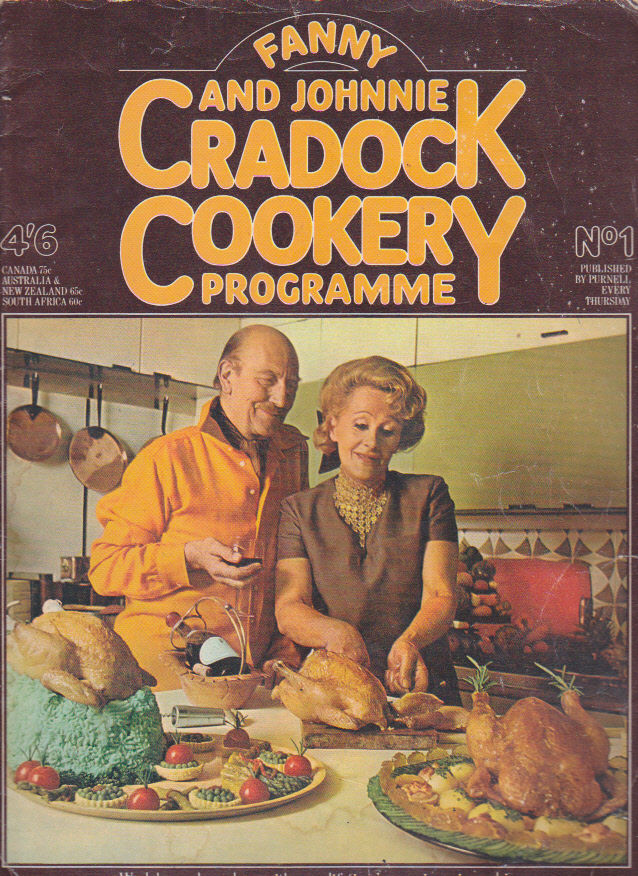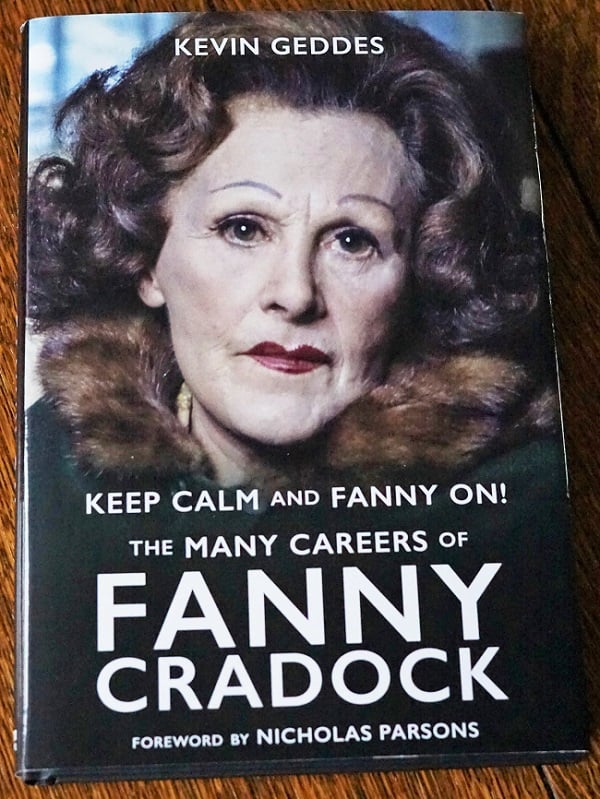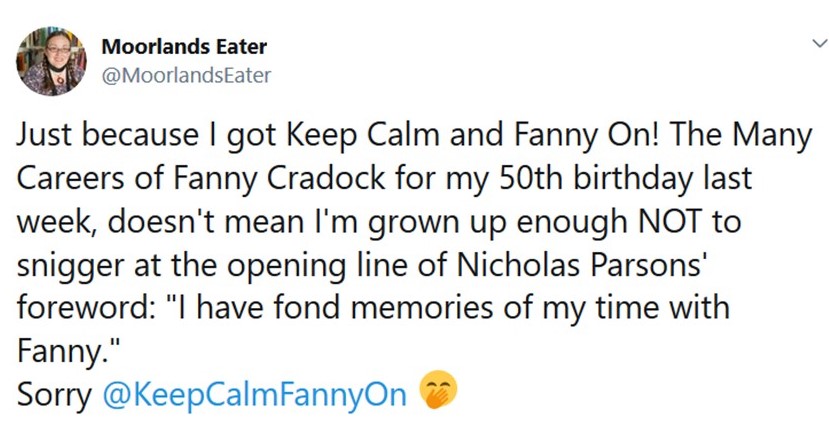Book Review: Keep Calm and Fanny On! The Many Careers of Fanny Cradock
Fanny Cradock’s multi-faceted and fascinating life is laid bare in Keep Calm and Fanny On! The Many Careers of Fanny Cradock by Kevin Geddes. I began by knowing little about this prolific TV cook, journalist, travel writer, poet, novelist, campaigner and businesswoman with a reputation for being ‘difficult’. But, through this entertaining yet thoughtful book, I came to admire her tenacity in striving for her goals and the life she wanted.
Published on the twenty-fifth anniversary of her death, and going beyond the public persona, the book is a timely look at the life and work of Fanny Craddock.
Despite spending much of my current life either cooking, eating, thinking about, writing about, photographing and sharing food, I confess that I wasn’t at all knowledgeable about one of the most well-known names in British cookery. Fanny Cradock.
Like many people, I’d seen some of the old TV clips of this striking-looking woman producing elaborately garnished dishes and bizarrely pinching the skin of a Christmas turkey as if she had a personal grudge against it.
I’m sorry to say that, also like many people, I wasn’t above making sniggering innuendos about ‘Fanny’. When, as per the request to my other half, I got Keep Calm and Fanny On! The Many Careers of Fanny Cradock for my birthday last month, I couldn’t resist including one in my social media posts about it.
But, beyond that hilarity-inducing name, I’d guess few of us know very much at all about Fanny Cradock.
AUTHOR KEVIN GEDDES
I’d been following Keep Calm & Fanny On on Twitter (aka Kevin Geddes) for some time and that’s how I heard about the book. He’s a Fanny Cradock fan who’s been writing about and cooking her recipes for many years.
Incredibly, there was no online resource dedicated to Cradock until Geddes began his blog where he cooked dishes from the weekly-instalment magazine The Fanny and Johnnie Cradock Cookery Programme.
But Keep Calm and Fanny On! The Many Careers of Fanny Cradock is no frothy puff piece written by an uncritical fan. Edinburgh-based Geddes wrote his Masters’ dissertation on Cradock’s work and is currently doing a PhD on the history and development of TV cookery shows.
In the book, his voice is largely in the background, quiet and unobtrusive, leaving the larger than life Fanny to rightly take centre stage.
MANY CAREERS
When you begin to read about Fanny’s multiple range of activities and furious work rate you’ll see why, apart from a few exceptions, the book’s divided and named with reference to her ‘many careers’. Forcing a linear structure on Fanny’s multi-faceted life would probably result in confusion. However, at times I did wish for a separate chronological timeline at the front or back to which I could quickly refer to get my bearings.
Geddes charts Fanny’s rise from girl, young mother and unpublished poet and novelist, through making do as a wartime hostess with home reared rabbits and hedgehogs baked in clay, to her first public appearances as the face of The British Housewives’ League and United Women food campaigns, protesting that ‘we are forced to surrender our meat ration to our husband and children.’
We’re then told about the huge amount of work which followed, taking us up to the start of the 1970s. I won’t repeat it all here as it’s covered in interesting detail in the book. Of course it includes her first cookery book, newspaper articles on a range of subjects and under a variety of names, radio and then television appearances with their linked books and recipe booklets, novels (two of which she claimed were dictated to her by a priest from the lost continent of Atlantis, dead for nine million years), children’s fiction, plus a growing celebrity status and appearance on shows like Call My Bluff and Juke Box Jury.
Most famously was the creation of Bon Viveur: a husband and wife team travelling Britain and Europe eating fabulous food, writing about it and eventually appearing on stage and television. This famously was with Johnnie, her third husband. Or was he her fourth? Fanny’s tangled marriages was another part of her life that was new to me
Whatever she was doing, Fanny gave it her all and worked like a demon to get where she wanted to be. She was always looking for opportunities to ‘build her brand’, as we would say today, and trying to make plenty of money so that she could live the glamorous lifestyle she wanted. Some say the way she went about doing that made her a bit of a she-devil.
REALITY VS FICTION
But perhaps Fanny’s greatest work was the creation of Fanny herself. Because, as the book makes clear, ‘Fanny’ was possibly just as much a fictional character as those in her Lormes of Castle Rising series of historical novels.
In fact, Geddes says Fanny’s first novel Scorpion’s Suicide (written under the pseudonym Frances Dale which she would use for much of her early career) may be ‘entirely more autobiographical’ than her actual autobiography, Something’s Burning.
In later life, Cradock claimed to have been born in the Channel Islands. Perhaps not coincidentally, she happened to be living there at the time, taking advantage of the lower tax rate. But the facts are that Cradock was born in Leytonstone in 1909 rather less than nine months after her parents married. Her birth name was Phyllis Nain Sortain Pechey. Throughout her ‘real’ life many close friends continued to call her Phyl.
At an early age Phyllis was ‘gifted’ to her grandparents with whom she lived until sent off to boarding school. Meanwhile, parents Bijou (if you think Fanny’s a diva, meet Bijou) and Archibald (a prolific writer, as Fanny was to become) had a favoured son whom they decided to keep at home.
Grandmother Emily seems to have been the biggest influence on the young girl. It was she who taught her deportment, reading and ‘making an entrance’.
She also seems to have learnt cooking from Gran, especially for parties. As with much of Fanny’s claimed history though, this story morphed over time. Initially she said she learnt by watching and absorbing how to cook at her grandmother’s home in England. Then it shifted to France, tying in with her occasional claim that she was half French and that the family name derived from de Peche. Finally, the story was that she learnt by watching the goings on in the kitchens of posh French hotels.
As a young woman, the truth of Fanny Cradock’s life was a long way from the glamorous one she both invented for herself and constantly strived for.
MOTHERHOOD & EARLY CAREERS
Even in the twenty first century, it seems that just about the worst insult you can say to a woman is that she’s a ‘bad mother’ or has no ‘maternal instinct’. Both were levelled at Fanny.
Running away to get married at just seventeen, Fanny quickly became pregnant. But even before their son Peter was born, Fanny’s husband, who was in the RAF, died in a plane crash.
Quickly rushing into a second marriage when Peter was still only six months old, Fanny gave birth to Christopher eight months later.
The unhappy marriage didn’t last long. Fanny left both husband and baby to move to a ‘hole in the wall’ flat in London.
Forced to earn her own living, and with a child in tow, she worked numerous jobs including washing up in a canteen, working in a grocers, as a door to door vacuum salesperson and, in a taste of what was to come, demonstrating how to bake packet Swiss rolls in front of an audience. She also set up herself, and three other women too, as dressmakers. Somehow, she found the time to submit poetry to magazines and write a two hundred and thirty page novel.
In this context, as the book points out, it isn’t hard to see why Fanny felt she couldn’t take the baby with her. This is around 1929 remember, when most middle-class women wouldn’t have had a job, let alone a career. And certainly not if they had children. Fanny didn’t see Christopher again until he was an adult. Her first son Peter was eventually adopted by his paternal grandparents, on the proviso that Fanny couldn’t see him until he was twenty-one.
Once you know the facts of her complicated life, including becoming a widow at a very early age, I think it’s unfair to accuse Fanny of abandoning her children, as people seem to have done.
I also doubt if final husband Johnnie, who left his wife and children to be with Fanny and had little to do with them afterwards, comes in for the same criticism.
Fanny did go on to see her children again as adults. However, the relationships were strained and especially so when her sons developed relationships with women.
FANNY & JOHNNIE
In the modern public mind, Fanny and Johnnie go together like her famous mashed potatoes and green food colouring. Inextricably linked, but a bit of a joke.
Despite their audience’s perception, which Fanny and Johnnie encouraged, the couple weren’t husband and wife for most of their public life. You’ll have to read the book to find out why.
Johnnie is often cited as evidence to demonstrate what a nasty piece of work Fanny was, treating him very badly in their public appearances.
But it seems to me that the apparently hen-pecked, monocled ‘Major Whitby Cradock’ is just as much a work of fiction as ‘Fanny’. There are numerous times in the book where Johnnie is cited as Fanny’s rock and the one person who could ‘keep her under control’. Indeed, it seems that after Johnnie’s death in 1988 she did go into rapid decline.
I think Fanny’s commitment and loyalty to Johnnie is clearly shown as we read about her fighting to get Johnnie included in appearances and even jointly credited for work which seems much more likely to have been hers alone.
FANNY AT THE BBC
I’m most familiar with Fanny from those iconic Fanny Cradock Cooks for Christmas shows on the BBC. They’re now regularly shown and, at the time of writing, can be watched on the iPlayer.
Although the BBC may laud Fanny these days, one of the really interesting things I learnt from Keep Calm and Fanny On was how she had to fight to get work on BBC television.
We’re told that Fanny never even got a long-term contract with the Corporation. She had to re-negotiate each and every series. All the equipment, from spoons, pots and pans to cookers and even the Christmas decorations were supplied by Fanny.
While the BBC recognised that much of her work was a hit with audiences, including huge sales of booklets to accompany her shows, she soon got a reputation for being ‘difficult’. Fanny was also renown for her sponsorship deals with companies who provided her with the products and equipment used in her shows and advertised in her books. This made her an easier fit with independent television.
A very enlightening section of the book relates how Fanny’s 1965 BBC series Home Cooking came about.
A ten-part series on basic cookery with accompanying recipe leaflet was to be funded by the Adult Education department. Despite the idea being one ‘she had been pitching to them for years’, the BBC did not want Fanny to present the show. However, hoping she would be knocked out at the audition stage, Fanny made it to the final five from a long list of twenty-seven. But, against the odds, Fanny’s ‘fresh, riveting, commanding’ performance triumphed at the audition.
I think Fanny’s fraught relationship with the BBC is also a good example of the woman’s tenacity. Having her ideas and suggestions rejected by the BBC and others, whether it be novels, TV programmes including game shows, cookery books or newspaper columns, she goes away, revises her ideas in the light of criticism and tries again.
HEYDAY TURNS TO DECLINE
Come the 1970s, and Fanny and Johnnie are changing gear as they start to plan towards eventual retirement.
Their vision that all the hard work would be taken over by the various helpers who shared their homes and appeared on their TV shows (hopefully, while they themselves sat back and the money rolled in) had come to nothing.
The pair got in early on the craze for those weekly instalment magazines that eventually form into a collection. However, The Fanny & Johnny Cookery Programme (the one that Geddes cooked his way through, minus the meat, in his blog) didn’t fulfil its initial success. It ended after eighty issues instead of the planned ninety-six.

Disturbingly, there are increasing signs in this period of Fanny’s seriously disjointed thoughts. Her never-to-be-published eleventh volume in the Lormes of Castle Rising series, set around the year 1949, is said to include anachronistic references to jeans and The Beatles.
Fanny’s link to psychic phenomena, as mentioned earlier with the books ‘dictated’ to her by a dead priest, came to the fore again when she and Johnnie were living in Ireland for tax reasons. It seems that, with money dwindling, they made attempts at faith healing as their new career. It failed.
It’s generally agreed that Fanny’s appearance on Esther Rantzen’s The Big Time led to her being largely off the TV other than on chat shows. Amateur cook Gwen Troake had won a competition to cook a lunch at The Dorchester for former Prime Minister Edward Heath and Fanny was brought in to give advice.
The details are all in the book and you can watch the clip, but I can’t help thinking that Fanny, and Gwen, were set up. Rantzen is quoted as saying, ‘[Fanny] was clearly a dragon lady; viewers like a bit of danger on television, and Fanny was always a danger.’ I think they deliberately got Fanny in, hoping she’d be rude, and she was.
Watching it again, I don’t think the appearance is as damning as it’s sometimes made out. But maybe I’m a bit of a Fanny too. Anyway, the very first thing she says after tasting Gwen’s coffee pudding is, ‘it’s very delicious of course’.
An appearance on TV-am in 1985 is also deemed to have gone badly. Although presenter Nick Owen is quoted as saying that enjoyed interviewing her, finding Fanny ‘spikey’ and ‘forthright’.
When Diana Henry, once a researcher on the Wogan chat show, tells her tale about the horror of dealing with Fanny, it looks like we’re heading for another disaster. But Fanny manages to turn things around and seems to charm both the audience and Terry.
After Johnnie died in 1988, Fanny is described as ‘falling apart’ without him. Living in a series of flats, apparently in squalor, she was finally moved to a care home near friends where she died in 1994 at the age of 85.
We learn that Fanny’s funeral was poorly attended, most of her family and celebrity friends having fallen away over the years.
LEGACY
Based on all I’ve learned from Kevin Geddes’ thoughtful yet entertaining book, I’d say that Fanny Cradock is due for a revival.
It’s certainly turned me from having a passing interest into someone on the road to becoming a Fanny fan.
Too long labelled as simply amusingly retro, ridiculously over the top and a downright horrible person, there seems to have been little consideration of her role in the development of television cookery as we know it today.
Unfortunately, as with many women, attention has been paid more to Fanny’s appearance and personality than her achievements. On one BBC clip show, which includes language it would be hard to imagine being used about a man, Esther Rantzen states baldly, ‘Fanny Craddock was a cow’. Anthony Worrall Thompson, whose mother worked with her, says he hid when she came to dinner as ‘you felt a witch had flown in… it was quite extraordinary how powerful she was.’
Of course we can’t simply dismiss her undeniably bad behaviour. But, as Geddes points out, Fanny grew up at a time when people having unloving childhoods or experiencing the trauma of bereavement were expected to just get on with it. Nowadays, we’re hopefully more enlightened about mental health issues and also dementia.
Placing the public persona into context, I think that Keep Calm and Fanny On! The Many Careers of Fanny Cradock will go some way in bringing to the fore her often overlooked achievements.
A highly recommended read.
Keep Calm and Fanny On! The Many Careers of Fanny Cradock published by Fantom (RRP £19.99) October 2019.


